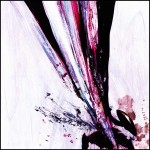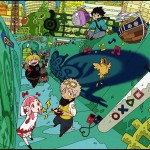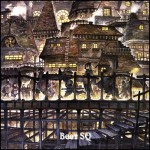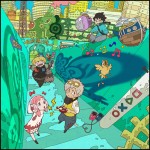The Final Fantasy XIII soundtrack is finally here! It’s surely one of the most anticipated soundtracks of the year, and here it is already. Ever since we learned that Masashi Hamauzu would be handling the score, we’ve had high hopes for the soundtrack and the game, and I have to say that Hamauzu doesn’t disappoint. You hopefully saw our unpacking video yesterday and already know what the packaging looks like, so we’re here to tell you about the music this time.
You’re definitely in for a lot of surprises. Hamauzu is known for his impressive piano work, but he goes well beyond that here, exploring a variety of genres and creating the most well polished Final Fantasy score to date featuring numerous live performers and even an orchestra. Even more, while some of the usual suspects appear in Final Fantasy XIII, you may be surprised by which Final Fantasy standards are missing this time around.
Intrigued? Hit the jump for our extensive review of the Final Fantasy XIII Original Soundtrack.
First, a few words about quality. Nearly every track on the album features some sort of live performance. The performer credits found in the booklet span two entire pages in a very small font. Square Enix has definitely spent big bucks on this soundtrack and it shows. From bombastic orchestra and choir, to session guitarists, to a number of individual vocalists, you’ll at least be impressed with the quality of what you’re hearing.
The opening tracks on the album are important ones, as they establish a foundation upon which the rest of the score is constructed. While “Prelude to Final Fantasy XIII” opens on a rather ominous note, it isn’t long before regal brass and strings come to the rescue with a very catchy and uplifting melody that demonstrates right from the start that Final Fantasy XIII is aiming to set itself apart from past Final Fantasy titles, discarding the series standard “Prelude” without a second thought. This track is followed by another important theme, “Final Fantasy XIII – The Promise,” a serene piano and woodwind piece that acts as a main theme of sorts, appearing multiple times throughout the game. I particularly enjoy the highly addictive techno and female vocal arrangement titled “The Sunleth Waterscape,” and much later, “Serah’s Theme,” which comes complete with a sweet female vocal accompaniment in English. “The Archylte Steppe” takes a dreamy approach to the theme, using what sounds to be a saxophone or bagpipe (it’s kind of buried under other elements) for the melody.
Another important track is the game’s battle theme, “Flash,” which you should know quite well by now. It’s been featured in several trailers as well as on the Square Enix Music Sampler CD Vol. 4 that we reviewed last year. It’s one of my favorite Final Fantasy battle themes in a long time, combining orchestral and rock elements in a very tasteful way. I particularly love the brass during the chorus section. The melody also finds its way into other tracks, including “Defiers of Fate,” which features a more electronic sound and replaces the brassy chorus section with a cinematic orchestral one. “Lightning’s Theme,” on the other hand, is an emotionally swelling orchestral arrangement that works in the original chorus section, giving it a classy twist.
While we’re on battle themes, let’s talk about “Saber’s Edge,” a powerful orchestral piece that acted as the “boss battle” theme in the demo. This is truly a great track, with some excellent piano work and lots of gentler passages that make for a unique battle theme. Much later, “Desperate Struggle,” a track that is interestingly arranged by Junya Nakano, is much more intense, featuring lightning-fast violin strokes and drawn out brass chords. There’s a flurry of rhythmic percussion sounds that really build the tension. “Fighting Fate” sounds like it could be a final battle theme with its focus on choir, orchestral percussion, and lots of brass that call out in warning. Lastly, “Will to Fight” opens with scalding synths that weave in and out of the mix and killer bass guitar that sounds like something out of “Hell March.” There are melancholy orchestral sections interspersed throughout, hinting at some internal conflict associated with this battle. Filtered and somewhat unsettling vocals are added towards the end, which was unexpected. This is one of those tracks that really make you want to play the game to find out what it’s all about.
“Battle Results” is another track that will become well known to players, and it’ a trip. A whir of electronic sounds, deep bass drum hits, and reverberating piano join a mysterious female choral section to create an altogether dreamy soundscape. An interesting approach for sure, and it’s no surprise that Mitsuto Suzuki is responsible for the arrangement on this one. Another electronic track, “The Vile Peaks,” incorporates fragments of conversation in the background as a whistling synthesizer cuts in and out of the mix. The deep voices of an all-male choir adds to the tribal feeling that the track gives off.
Hamauzu also shows his cinematic side with this score. There are a number of short cues featured throughout the soundtrack that work to build tension or accentuate a mood, including “The Thirteenth Day” that sounds like a buildup from a horror flick and “Forever Fugitives,” which speeds along at a blurring pace, weaving in memorable bits of melody from “The Promise” with strings and brass. “To Hunt L’Cie” is an intense action cue that spills over with energy, and features an awesome xylophone progression reminiscent of “Don’t be Afraid” from Final Fantasy VIII. While I typically find orchestral hits kind of cheesy, Hamauzu masterfully incorporates them into “No Way to Live,” which also utilizes heavy pistons, metallic clangs, string stabs, and an incredibly gnarly brass progression. Finally, I want to mention “The Pompa Sancta,” which actually got a chuckle out of me for its bombastic orchestral segments that sound like something out of Star Wars.
While there’s a lot of orchestral and electronic music here, that’s not all Hamauzu has hidden up his sleeves. “Daddy’s Got the Blues” is a swanky track with live harmonica and rich acoustic guitar that go back and forth in a sort of call and response before joining forces. Next, “Sazh’s Theme” is a groovy jazz experiment with piano, acoustic guitar, and even drum solos to go along with the funky time signature. “The Yaschas Massif” takes us into bossa nova territory, while “Taejin’s Tower” works in didgeridoo and some strange boingy sounds, giving off a tribal vibe. Both “Hope Theme” and “This Is Your Home” are melancholy acoustic guitar tracks that I found to be rather surprising from Hamauzu. While they are somewhat depressing, they are equally beautiful and effective as solo guitar tracks. Getting into some rock, Snow must be one serious badass, as “Snow’s Theme” opens with single explosive bursts of electric guitar and rock percussion before it gets going. Once moving, chugging electric guitars and snappy rock percussion provide a foundation for a heavily distorted and filtered electric guitar melody that calls out from the distance. At this point we’re treated to “Eternal Love (Short Version)” by Sayuri Sugawara. It’s rnb in style with smooth electric piano chords and snappy percussion, but it’s pretty standard stuff as far as this style goes. It’s still interesting to hear Hamauzu’s take on the style.
Ambient music appears here in a big way, and I must say that I love what Hamauzu has done. Interestingly, one of the most abstract ambient pieces is “Game Over,” an otherworldly track with airy pads and a swirling piano progression. It sounds like a void with random sounds calling out from the distance. “Those For the Purge” is an icy track combining dense electronic percussion and chilling belltones with a beautiful orchestral backing to create an amazing atmosphere. “The Vestige,” on the other hand, sports layers of droning pads and female voices that lure you into the bright soundscape like sirens. “The Gapra Whitewood” has to be one of my favorite tracks, opening with blinding pads, dancing piano, and a dreamy female voice that goes for a spacey new age sound. “Dust to Dust” is an amazing lullaby-esque track. It features a moving combination of strings and pads to create a warm blanket for the distant and reverberating vocals that sound like they’re calling out from space.
And now the moment you’ve been waiting for: the chocobo theme! As sick as I am of the chocobo theme, it’s always interesting to hear another composer’s take on it. “Chocobos of Cocoon – Chasing Dreams” is a dancey version with thumping techno percussion and layers of filtered synths that are appropriately quirky. Oh, and there’s some vocaloid for good measure. It’s wacky, but hey, it’s the chocobo theme. The other chocobo track, “Chocobo of Pulses” (perhaps they meant “Pulse de Chocobo”) is a fun 70s funk arrangement with lots of brass and bass. Piano works its way in and out of the forefront of the mix, although I think I prefer the trumpet the most. I have to say that it’s probably one of my favorite versions of the chocobo theme out there.
Tracks like “In The Sky That Night” and “A Brief Respite” are classic Hamauzu. The former is a playful ditty featuring a doubled-up woodwind and belltone melody that references “The Promise,” while the latter comes as a waltz. “March of the Dreadnoughts” also plods along in typical Hamauzu fashion with a piano doing double duty: both keeping the pace and providing a chaotic backing for this adventurous “space Western.” The unique piano effects in “Separate Paths” are worth mentioning, as the rapid back and forth between two notes almost makes it sound like a vibrato effect, which I’ve never heard done on the piano before. “Promised Eternity” is also mainly a piano offering, but strings join towards the end to lend their support, making for a highly emotional ballad that will have you feeling pretty down, if not in tears, by the end.
Getting towards the end, “Start Your Engines” is a punchy track that sounds completely synthetic with all synthesized instruments, reminding me a bit of Vince DiCola’s work. I’d describe “The Cradle Will Fall” as “Eartbound-esque,” as it’s some seriously messed up stuff, sounding like distorted music coming from a radio that’s between frequencies. Eventually an enveloping bass pad emerges from the void along with the heavy thuds of a bass drum. This doesn’t sound like a place you want to be. Nothing says the end of a Final Fantasy game like orchestra and a choir with Latin lyrics. “Born Anew” definitely goes in that direction, but isn’t particular memorable. “Nascent Requiem” is what I believe to be the final boss theme. It’s not nearly as epic as previous final battles in the series, but is rather eerie and tense. It’s very cinematic, moving from one idea to the next, taking a very ambient approach.
“Fabula Nova Crystallis” in an emotional orchestral piece, with its title referencing the series of games that Square Enix is producing within the Final Fantasy XIII universe (Versus and Agito). “Final Fantasy XIII – Miracles,” on the other hand, is much more hopeful, referencing the catchy Final Fantasy XIII prelude from the first disc. At this point, we’re treated to another J-pop track from Hamauzu and Sugiwara titled “Kimi ga Irukara (Long Version).” While it’s a standard pop ballad and not all that catchy in comparison to past Final Fantasy vocal themes, it is very well produced, and is definitely much better than the Leona Lewis track that Square Enix is subbing in for regions outside of Japan. The final track is the surprisingly short “Ending Credits,” which falls in at under five minutes, and is more contemplative than triumphant. I’m sure you’ve guessed it by now, but yes, “The Promise” is featured prominently in this track. I guess they were truly going for something new with Final Fantasy XIII, as neither “Final Fantasy” or the series standard “Prelude” make an appearance, even in the credits.
And there you have it. You’ve seen the standard edition packaging in our unpacking video, but I’ll say again that the packaging is littered with beautiful artwork, which you’ll get even more of if you get the first press edition. This is a fitting goodbye to Masashi Hamauzu, as I not only see it as his best work to date, but also one of the best Final Fantasy scores in recent years. He’s risen up to the challenge of scoring the most popular RPG franchise in the world, and he has performed to the highest level. I love the fact that Square Enix splurged on this game’s soundtrack, as I feel it gave Hamauzu the tools he needed to succeed. I’m more excited for this game than ever after hearing this soundtrack, and you should be too once you hear it. Pick it up immediately at either CD Japan or Play-Asia.
Are you impressed by what Hamauzu was able to accomplish with the Final Fantasy XIII soundtrack? Are you surprised that he left out many iconic Final Fantasy themes?
Tags: Final Fantasy, Final Fantasy XIII, Masashi Hamauzu, Music Reviews, Reviews, Square Enix, Videogame









































To me this is the best Final Fantasy soundtrack to date, but not my favourite work of Hamauzu’s. It’s growing on me because of the astonishing quality of the work but I’m unsure of what to think of it. The Nobuo soundtracks feel like the man was free to do whatever he wants, but it’s not what I feel from 12 and 13.
I will still loop Pulse de Chocobo (renamed it, haha) forever more. Sometimes I might go back to Coi Vanni Gialli for some chocobo greatness.
I approve of the Rocky / Eye of the Tiger reference in the title.
I think the choice to leave out the iconic FF themes may not have been Hamauzu’s, or at least not his alone. I was a little surprised by it, but it is appropriate that the music “move on” with the rest of the elements of this entirely new kind of FF. Chocobo survived, so that’s good. 🙂
And of course, I am impressed. Good stuff all around.
Spectacular review. Before I make a few comments, please allow that I echo almost all the praise offered above, especially regarding the revelation of Hamauzu’s range of talent. ‘Daddy’s got the blues’ really took me by surprise, and ‘Pulse de Chocobo’ is easily my favourite arrangement of the classic tune.
There’s an interesting trend regarding what I consider the highlights of the past few multi-composer FF soundtracks (i.e. X, and now XIII). ‘Blinded by light’, or ‘Flash’ (if you translate the kanji directly), was a standout on the demo, and I thought it really showcased Hamauzu’s progression from X. Now, ‘Assault’ was one of my favourite X tracks, and of course it wasn’t by Uematsu, who was still credited as the prime composer of X. Hamauzu, who did create ‘Assault’, is credited as the prime composer of XIII…but from what I can tell, Ryo Yamazaki is responsible for ‘Blinded by Light/Flash’, and a few other of the tracks on XIII that I’d consider exemplary or at the very least catchy and memorable.
I loved the unexpected vocal touches to the XIII ost. Now and then you’ll be lulled into what seems like a simple field theme, and then singing will emerge from the mist.
I felt that ‘Born Anew’ might be the end-boss, given its bombastic choral elements, and that ‘Nascent Requiem’ might be a cinematic, in consideration of how close it is to the end. Either way, ‘Decisive Battle’ from X blitzed either of them, musically. Oho, blitzed. I’m terrible.
Naturally, my main criticism of the album is precisely the thing that drew me to it: it occasionally sounds a little too much like Hamauzu’s work from X for me. But at its best, this familiarity is infused with new flourishes and directions — again, what I took ‘Flash’ to be.
A friend of mine, just now finishing the Japanese version, is horrified that I have listened to the soundtrack before playing it, and although I am bound by my tenets as a VGM devotee in my belief that a truly great OST stands by itself, I think this is one case where my opinion of the OST will be elevated by the gaming experience for which it was written. Unlike an Ys game, where I gorge on the soundtrack then play it, dying to see what rocking tune goes where, XIII is far, far more narrative-and-character driven, so I feel my experience of the OST when playing it will be more flashes of recognition than anticipation of entire tracks.
The point to all that is, although it goes against my grain, I sort of regret not waiting for the game.
EDIT: the track ‘Final Fantasy XIII – Miracles’ has a really strange Taku Iwasaki feel to it, particularly the lonely flute isolation at 1:34 or so.
@Patrick: Oh lord I knew I recognised it! I was like…FFXIII? Rivals? What…? hahahha. Oh dear.
Hello, Jayson.
I recently saw my brother playing this PS3 hits games, and I love the music, is very amazing, totally blew me away.
I knew this might late to purchase, or just for the limited version.
I check out the album from CDJapan, the limited is out of stock (that’s a bad news).
Then I saw Amazon.com still have both edition,
I need your suggestion, could you give me an idea, what edition should I purchase?
Because some review say (according from Amazon.com customers review ) the limited album had some “weird sound”, or “Regular version better than the limited”…
Anyway, if I purchase the regular, will I missing anything thing??
Thank you, please help me 🙂